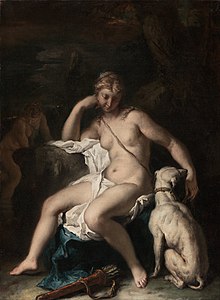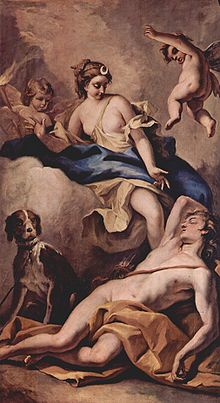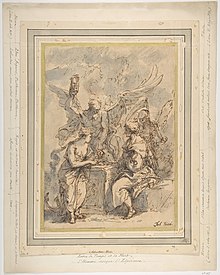Sebastiano Ricci
Sebastiano Ricci | |
|---|---|
 The Adoration of the Kings, 1726 (Royal Collection) | |
| Born | 1 August 1659 |
| Died | 15 May 1734 (aged 74) Venice, Italy |
| Nationality | Italian |
| Occupation | Painter |
| Spouse | Unidentified wife (m. 1691) |
| Children | 1 |
| Family | Marco Ricci (nephew) |
Sebastiano Ricci (1 August 1659 – 15 May 1734) was an
He was the uncle of Marco Ricci (1676 – 1730), who trained with him, and became an innovator in landscape painting.
Early years
He was born in Belluno, the son of Andreana and Livio Ricci. In 1671, he was apprenticed to Federico Cervelli of Venice. Others claim Ricci's first master was Sebastiano Mazzoni. Indiscretion at a young age in 1678 resulted in an unintended pregnancy and, later, a bigger scandal when Ricci was charged with trying to poison the young woman in question to avoid marriage. He was imprisoned, and released only after the intervention of a nobleman, probably a Pisani family member. He eventually married the mother of his child in 1691, although this was a stormy union.
Following his release he moved to Bologna, where he lived near the Parish of San Michele del Mercato. His painting style there was apparently influenced by Giovanni Gioseffo dal Sole. On 28 September 1682 he was contracted by the "Fraternity of Saint John of Florence" to paint a Decapitation of John the Baptist for their oratory.
On 9 December 1685, the Count of
Turin and return to Venice
The death of the Duke Ranuccio in December, 1694, who was also his protector, forced Ricci to abandon Rome for
In 1698, he returned to the Venetian republic for a decade. By 24 August 1700, he had frescoed the chapel of the Santissimo Sacramento in the
In Venice in 1704 he executed a canvas of San Procolo (Saint Proculus) for the Dome of Bergamo and a Crucifixion for the Florentine church of San Francisco de Macci.
Florentine frescoes
In the summer of 1706, he traveled to
In 1708 he returned to Venice, completing a Madonna with the Child for San Giorgio Maggiore. In 1711, now painting alongside his nephew, Marco Ricci, he painted two canvases: Esther to Assuero and Moses saved from the Nile, for the Taverna Palace.

London and Paris


He ultimately accepted foreign patronage in London, when he was provided a £770 commission by

He decorated the chapel at Bulstrode House near Gerrards Cross for Henry Bentinck, 1st Duke of Portland with a cycle of wall-paintings depicting scenes from the life of Christ. George Vertue described the scheme as "a Noble free invention. great force of lights and shade, with variety & freedom, in the composition of the parts". The chapel was demolished in the 19th century, but oil modelli still exist.[1] Ricci also designed stained glass for the Duke of Chandos' chapel at Cannons. In c. 1710–15 Ricci painted the apse in the chapel at the Royal Hospital Chelsea of the resurrection.
By the end of 1716, with his nephew, he left England for Paris, where he met

Last years
From 1724 to 1729, Ricci worked intensely for the Royal
Ricci's style developed a following among other Venetian artists, influencing Francesco Polazzo, Gaspare Diziani, Francesco Migliori, Gaetano Zompini, and Francesco Fontebasso (1709–1769).[3]
He died in Venice on 15 May 1734.
Veronese copies
Ricci made many copies from the works of Paolo Veronese, both of individual heads and of whole compositions. Some of these copies of heads were bought by George III. The king also bought a painting of the Finding of Moses which his agent, Joseph Smith, claimed was a Veronese, although this too had been painted by Ricci, either as a pastiche of Veronese's style, or a copy of a work now lost.[4] Ricci painted a supposed portrait of Andrea Palladio, attributed to Veronese and engraved by Bernard Picart for the frontispiece of the first English edition (1715) of Palladio's Four Books of Architecture. According to Rudolf Wittkower, it does not depict Palladio, but rather is entirely the invention of Ricci.[5]
Critical assessments
"Ricci, leaning at first on the example of splendid art of the
"He is the master of a resurrected-fifteenth century style, whose painterly features are enriched with nervous express and, typically 17th century" (Rudolf Wittkower). Wittkower in his Anthology, contrasts the facile luminous style of Ricci with the darker, more emotional intense painting of Piazzetta. Like Tiepolo, Ricci was an international artist; Piazzetta was local.
"We perceive in him that synthesis of the baroque decorativeness and individualized and substantial painting, that we will see later again in Tiepolo. On one side the influence of Cortona, directed and indirect, and on the other the observant painting of the hermit Magnasco; more intense, substantial and freed academic impulses, the airy, shining influences become, to the open air, magical coves, as well as gloomy corners. A new synthesis that opened wide new painting horizons, even if the scene is not that of a ballet, it is felt like bing in the wonders of the color, in more vibrating, acute, agile accents "(Moschini).
"At the start of the Baroque..Venetians remained isolated from the outside…from the great ideas of the baroque painting… The Ricci are the first traveling Venetian painters... and succeed to inaugurate the so-called roccoco rooms of Pitti and Marucelli palaces."(Roberto Longhi).
Ricci "brought back in the Venetian tradition a wealth of chromatic expression resolved in a new vibrating brilliance brightness…by means of the intelligent interpretation of the Veronese chromatics and of the brushstrokes of a Magnasco-like touch, from the 16th century impediments, he takes unfashionable positions against "tenebrous styles", is against the new Piazzetta – Federico Bencovich. He supplied a valid painterly idiom for ... Tiepolo to use after his defection from the Piazzettism "(Pallucchini).
"Venice, still more than Naples, collects the Ricci inheritance of the prodigioso trade of Luca Giordano... Sebastiano throws again it, widens he then, refines it for the school of Sebastiano Mazzoni "(Argan)




Works/Gallery
- Portrait of a Bishop, Landesmuseum Ferdinandeum, Insbruck
- Mercy (1686), New Church of the Capuchins, Parma
- Frescoes in collaboration with Bibiena, (1687) Sacristy of the Fallen in Church of Santo Segundo, Parma
- History and Apotheosis of Paul III (1687–1688), Farnese Palace, now Pinacoteca Civica, Piacenza
- Guardian Angel (1694), Chiesa del Carmine, Pavia
- Frescoes (1695), Church of San Bernardino alle Ossa, Milan
- Ecstasy of St Francis (ca 1695–96), Tweed Museum of Art, Duluth, Minnesota
- Last Supper (ca 1720), Houston, Texas
- Frescoes(1697), Duomo of Monza
- Communion of St Maria Egiziaca (1698), Archconfraternity of the Duomo of the Santa Sindone, Milan
- St Gregory the Great intercedes with Madonna (1700), Church of Santa Giustina, Padua
- Frescoes (1700), Church of Santa Giustina, Padua
- Ascension (1701), Santi Apostoli, Rome
- Allegory of the princely virtues (1702), Schönbrunn Palace, Vienna
- Assumption of Virgin (1702) Gemäldegalerie, Dresden[6]
- Crucifixion with Virgin, John the Evangelist and Carlo Borromeo (1704), Uffizi, Florence
- Procolo, Peasant Detention (1704), Duomo, Bergamo)
- Vision of St. Bruno (1705) [1] [2]
- Frescoes (1706–1707), Palazzi Fenzi Marucelli & Pitti, Florence
- Madonna with Child (1708), San Giorgio Maggiore, Venice)[3]
- Family of Darius before Alexander & Continence of Scipio (ca 1709), North Carolina Museum of Art, Raleigh
- Liberation of Saint Peter (1710), Trescore Balneario, Bergamo, church of Saint Peter)(San Stae)[4]
- Christ giving the keys to St Peter & Call of St Peter (1710), San Pietro, Bergamo
- Assumption (1710), Santa Maria Maggiore, Bergamo)
- Esther before Ahasuerus (1711), Palazzo Taverna, Rome
- Moses saved from the waters (1711)
- Sacred Family with Elizabeth and John (1712), Royal Collections, London
- Frescoes for Burlington House (1712–1714), London
- Cupid before Jove; Encounter of Bacchus and Ariadne; and Triumph of Galatea
- Frescoes for Chiswick House (1712–14), London
- Bacchus and Ariadne (National Gallery)[5]
- Venus and Cupid, Diana and Endymion, Cupid and Flora, and Diana and Nymphs
- Selene & Endymion (1713), London
- The Resurrection (1714), Royal Hospital Chelsea, London
- Triumph of Wisdom over Ignorance (1718), Louvre, Paris
- Head of Woman (1718), fresco fragment, Civic Museum, Belluno
- Szépművészeti Múzeum, Budapest
- Sabauda Gallery, Turin
- Repudiation of Agar and Solomon adores the Idols (1724)
- Madonna in Glory with archangel Gabriel and Saints Eusebio, Sebastiano & Rocco (1725)
- Susanna in front of Daniel and Moses make water gush from the rock (1726)
- Magdalen applies ointment to Christ's feet (1728)
- Apotheosis of Saint Sebastian (circa 1725), Musée des Beaux-Arts, Strasbourg
- St Cajetan heals the Sick (1727), Brera Gallery, Milan
- Ecstasy of St. Teresa, (1727, Church of St Jerome (now St Mark), Vicenza)
- Royal Palace, Turin
- Hagar in the desert; Jacob blesses the sons of Joseph; Moses saved from waters; and Rebecca and Eliazer at the well (1727)
- Christ and the Centurions and Wedding at Cannae, (1729), Capodimonte Museum, Naples
- Communion and Martyrdom of St Lucia (1730), Church of Santa Lucia, Parma
- Immaculate Conception (1730), Church of San Vitale, Venice
- Madonna in Glory with Child and Angel Guardian, (1730) Scuola of the Guardian Angel, Venice
- Prayer in Garden, (1730), Kunsthistorisches Museum, Vienna [6]
- Self-portrait (1731), Uffizi Gallery
- Pope Gregory the Great intercedes with Virgin (1731), Sant'Alessandro della Croce, Bergamo
- Pope Gregory the Great intercedes for souls in Purgatory, (1733), Saint Gervais, Paris
- Pope Pio V, Saints Thomas Acquinus, & Peter Martyr (1733), Gesuati, Venice
- St Francis from resuscitates child Paola and St Helen discovers True Cross, San Rocco Church, Venice
- Baldassarre and Ester before Ahasuerus (1733), Quirinal Palace, Rome
- Assumption (1734) Karlskirche, Vienna
References
- ^ "The Baptism of Christ Sebastiano Ricci (Italian, Belluno 1659–1734 Venice)". Metropolitan Museum of Art. Retrieved 3 December 2012.
- ^ Giambattista Tiepolo 1698–1770 1996, p. 41.
- ^ Wittkower 1993, p. 481.
- ^ Giambattista Tiepolo 1698–1770 1996, p. 131.
- ^ Nash 1999, pp. 1347–1349; Wittkower 1974, p. 82, cited by Nash.
- ^ "Ricci, Sebastiano". Web Gallery of Art. Retrieved 2015-03-10.
Sources
- Free translation from Italian Wikipedia entry
- Giambattista Tiepolo 1698–1770 (Exhibition catalogue). New York: Metropolitan Museum of Art. 1996.
- Nash, Paul W.; Savage, Nicholas (1999). Early Printed Books 1478–1840: Catalogue of the British Architectural Library, Early Imprints Collection. London: Bowker-Saur. ISBN 9781857390186.
- Rizzi, Aldo. Sebastiano Ricci disegnatore, Electa – Milano 1975
- Rizzi, Aldo. Sebastiano Ricci, Electa – Milano 1989
- Wittkower, Rudolf (1974). Palladio and English Palladianism. London: Thames and Hudson. ISBN 9780500850015.
- Wittkower, Rudolf (1993). Art and Architecture in Italy, 1600–1750. Penguin Books. pp. 480–82.
External links
![]() Media related to Sebastiano Ricci at Wikimedia Commons
Media related to Sebastiano Ricci at Wikimedia Commons
- 43 artworks by or after Sebastiano Ricci at the Art UK site
